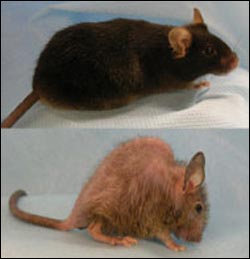Gene loss accelerates aging

8-month-old normal (top) and p63 deficient mice. Courtesy Alea Mills, Cold Spring Harbor Laboratory
Researchers have discovered that the loss of a gene called p63 accelerates aging in mice. Similar versions of the gene are present in many organisms, including humans. Therefore, the p63 gene is likely to play a fundamental biological role in aging-related processes.
“To study how the p63 gene works, we devised a system for eliminating it from adult mouse tissues. What struck us right away was that these p63 deficient mice were aging prematurely,” says Alea Mills of Cold Spring Harbor laboratory, who led the research.
Mice that are born without the p63 gene do not survive. Therefore, Mills had previously conducted extensive studies of mice that are born with only one copy of the gene. Still, these animals die at a young age. So to study p63 function in adults, Mills and her colleagues devised a sophisticated molecular genetic technique that enabled them to eliminate both copies of the gene from particular tissues–including skin and other multi-layered epithelial tissues–after the animals reached maturity.
The effects of premature aging observed in these p63 deficient mice (image available on request) were hair loss, reduced fitness and body weight, progressive curvature of the spine, and a shortened lifespan.
“Aging and cancer are two sides of the same coin. In one case, cells stop dividing and in the other, they can’t stop dividing. We suspect that having the right amount of the p63 protein in the right cells at the right time creates a balance that enables organisms to live relatively cancer-free for a reasonably long time,” says Mills, who adds that this is the first time the p63 gene has been implicated in aging.
“I first presented these results at a meeting in Tuscany. I don’t want to sound flippant, but if you have to grow old somewhere, that’s about as good a place as any to do it,” says Mills.
The study is published in the September issue of the journal Genes & Development (advance online publication August 17). The other researchers involved in the study were Scott Lowe, Ying Wu, Xuecui Guo, and first author William Keyes of Cold Spring Harbor Laboratory, and Hannes Vogel of Stanford University.
Researchers who did not participate in the study but are familiar with its findings include:
Carol Prives (Columbia University); Judith Campisi (Lawrence Berkeley National Laboratory); David Lane (University of Dundee); Lawrence Donehower (Baylor College of Medicine)
Media Contact
More Information:
http://www.cshl.eduAll latest news from the category: Life Sciences and Chemistry
Articles and reports from the Life Sciences and chemistry area deal with applied and basic research into modern biology, chemistry and human medicine.
Valuable information can be found on a range of life sciences fields including bacteriology, biochemistry, bionics, bioinformatics, biophysics, biotechnology, genetics, geobotany, human biology, marine biology, microbiology, molecular biology, cellular biology, zoology, bioinorganic chemistry, microchemistry and environmental chemistry.
Newest articles

Superradiant atoms could push the boundaries of how precisely time can be measured
Superradiant atoms can help us measure time more precisely than ever. In a new study, researchers from the University of Copenhagen present a new method for measuring the time interval,…

Ion thermoelectric conversion devices for near room temperature
The electrode sheet of the thermoelectric device consists of ionic hydrogel, which is sandwiched between the electrodes to form, and the Prussian blue on the electrode undergoes a redox reaction…

Zap Energy achieves 37-million-degree temperatures in a compact device
New publication reports record electron temperatures for a small-scale, sheared-flow-stabilized Z-pinch fusion device. In the nine decades since humans first produced fusion reactions, only a few fusion technologies have demonstrated…





















